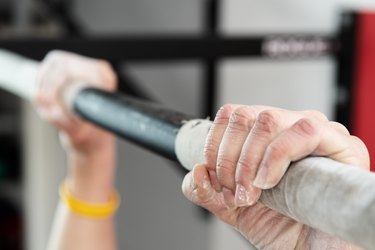
You will find lifting chalk — magnesium carbonate — in almost every gym. Yet there's been very little research on the impact of using this substance for improving your grip while weightlifting. It can help you in some situations and hinder you in others. Knowing the advantages and disadvantages of lifting chalk can help you decide when to use it.
Tip
Increasing the friction between a piece of exercise equipment and your hands using lifting chalk will likely increase your performance, according to a June 2016 review in the Strength and Conditioning Journal.
Video of the Day
Read more: Eight Reasons Why Women Should Lift Weights
Video of the Day
Advantages of Lifting Chalk
No readily available study has directly tested the impact of lifting chalk on weightlifting. Yet several studies have provided facts relevant to this topic.
A January 2018 paper in the International Journal of Exercise Science may provide the best evidence. These researchers tested the effect of magnesium carbonate in nine subjects doing weight-assisted pull-ups with two different hand positions. The results indicated that lifting chalk improved performance by about 16 percent using an open grip and 58 percent using a pinch grip.
A March 2015 article in the Journal of Advanced Mechanical Design, Systems and Manufacturing also indirectly supports the idea that lifting chalk will help improve your grip during weightlifting. The researchers tested 15 subjects and showed that magnesium carbonate increased the friction of a gloved hand sliding down a thin steel cylinder very similar to a weightlifting bar.
Another line of supportive evidence comes from gymnastics. The authors of a January 2014 report in the Science of Gymnastics Journal tested seven participants and indicated that using magnesium carbonate increased subjects' grip on the wooden bars of a piece of gymnastics equipment. Interestingly, the authors expressed concern that the chalk might provide too much grip and cause blisters.
Disadvantages of Lifting Chalk
Unfortunately, lifting chalk might decrease your grip in some situations. For example, a March 2012 report in the Proceedings of the Institution of Mechanical Engineers showed that, for a single participant, powdered chalk decreased the finger friction of sliding across a dry, polished steel surface. The authors of this study believed, that under these conditions, powdered chalk acted like a lubricant instead of a grip aid.
A September 2016 article in the Journal of Applied Biomechanics revealed another disadvantage of lifting chalk. While most people believe that sweat decreases hand friction, having a small amount of moisture actually increases friction. Lifting chalk thus might decrease the grip by removing too much moisture. You apparently need just the right amount of moisture to get the best grip. Unfortunately, you might need to alter your perspiration rate using a sweat blocker like petroleum jelly to find an effective balance between adhesion and lubrication.
Read more: Do You Gain Weight When Lifting Weights?
Safety of Lifting Chalk
The U.S. Food and Drug Administration (FDA), considers magnesium carbonate safe, according to an October 2015 report in the Journal of Biomaterials and Nanobiotechnology. The authors of that study also found no evidence of toxicity using an animal model. No known cases of allergic reactions to lifting chalk exist, but there's always a chance that you will have a chemical sensitivity to the chalk or an additive. So do a test run by applying only a small amount to your hands during your first use.
Using lifting chalk can create a bit of a mess, but a weightlifting chalk bag can limit the stray dust to a small area. Yet, despite this precaution, a November 2014 paper in Environmental Science and Pollution Research International demonstrated that using lifting chalk will decrease the air quality of an indoor facility. Many gyms have thus banned lifting chalk. But an August 2012 article in the Journal of Environmental Monitoring showed that using liquid chalk prevents this problem.
- Strength and Conditioning Journal: "Review of the Efficacy of Weight Training Aids"
- International Journal of Exercise Science: "Effect of Magnesium Carbonate Use on Repeated Open-Handed and Pinch Grip Weight-Assisted Pull-Ups"
- Journal of Advanced Mechanical Design, Systems and Manufacturing: "Magnesium Carbonate and Rosin Powders Stabilize Sliding Motion Between Rubber-Gloved Human Hand and Grasped Cylindrical Bar"
- Science of Gymnastics Journal: "Thermal Imaging of Hands During Simple Gymnastics Elements on the Wooden Bar With and Without the Use of Magnesium Carbonate"
- Proceedings of the Institution of Mechanical Engineers: "Assessment of the Performance of Grip Enhancing Agents Used in Sports Applications"
- Journal of Applied Biomechanics: "Effect of Magnesium Carbonate (Chalk) on Geometric Entropy, Force and EMG During Rock Climbing"
- Journal of Biomaterials and Nanobiotechnology: "Cytotoxicity, in Vivo Skin Irritation and Acute Systemic Toxicity of the Mesoporous Magnesium Carbonate Upsalite"
- Environmental Science and Pollution Research International: "Particulate Matter in the Indoor and Outdoor Air of a Gymnasium and a Fronton"
- Journal of Environmental Monitoring: "Reducing Dust Exposure in Indoor Climbing Gyms"